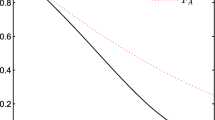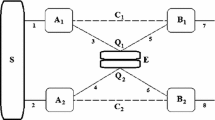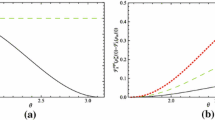Abstract
The quantum teleportation is reexamined in a Fisher information perspective. Two proposals of enhancing the teleportation of quantum Fisher information (QFI) under amplitude damping channel are proposed by utilizing the weak measurement and environment-assisted measurement (EAM), respectively. Although both schemes enable us to improve the teleportation of QFI with a certain probability, the latter proposal can completely recover the initial QFI, while the former only approaches to it. A detailed comparison confirms that the scheme of EAM outperforms the WM one in the improvements of QFI. The underlying reason is that the EAM is a post-measurement; thus, it extracts more information from the system and environment than the pre-posed WM. Our research offers an active way to enhance the teleportation of QFI under the amplitude damping decoherence, which is very important for quantum metrology and other quantum information tasks.





Similar content being viewed by others
References
Bennett, C.H., Brassard, G., Crépeau, C., Jozsa, R., Peres, A., Wootters, W.K.: Teleporting an unknown quantum state via dual classical and Einstein-Podolsky-Rosen channles. Phys. Rev. Lett. 70, 1895–1899 (1993)
Pirandola, S., Eisert, J., Weedbrook, C., Furusawa, A., Braunstein, S.L.: Advances in quantum teleportation. Nat. Photon. 9, 641–652 (2015)
Yu, T., Eberly, J.H.: Sudden death of entanglement. Science 323, 598–601 (2009)
Almeida, M.P., de Melo, F., Hor-Meyll, M., Salles, A., Walborn, S.P., Souto Ribeiro, P.H., Davidovich, L.: Environment-Induced sudden death of entanglement. Science 316, 579–582 (2007)
Popescu, S.: Bell’s inequality versus teleportation: What is Nonlocality? Phys. Rev. Lett. 72, 797–800 (1994)
Lee, J., Kim, M.S.: Entanglement teleportation via Werner states. Phys. Rev. Lett. 84, 4236–4239 (2000)
Bose, S., Vedral, V.: Mixedness and teleportation. Phys. Rev. A 61, 040101(R) (2000)
Oh, S., Lee, S., Lee, H.: Fidelity of quantum teleportation through noisy channels. Phys. Rev. A 66, 022316 (2002)
Ozdemir, S.K., Bartkiewicz, K., Liu, Y.X., Miranowicz, A.: Teleportation of qubit states through dissipative channels: conditions for surpassing the no-cloning limit. Phys. Rev. A 76, 042325 (2007)
Jung, E., Hwang, M.R., Ju, Y.H., Kim, M.S., Yoo, S.K., Kim, H., Park, D., Son, J.W., Tamaryan, S., Cha, S.K.: Greenberger-Horne-Zeilinger versus W state: Quantum teleportation through noisy channels. Phys. Rev. A 78, 012312 (2008)
Knoll, L.T., Schmiegelow, C.T., Larotonda, M.A.: Noisy quantum teleportation: an experimental study on the influence of local environments. Phys. Rev. A 90, 042332 (2014)
Giovannetti, V., Lloyd, S., Maccone, L.: Quantum metrology. Phys. Rev. Lett. 96, 010401 (2006)
Giovannetti, V., Lloyd, S., Maccone, L.: Advances in quantum metrology. Nat. Photon. 5, 222–229 (2011)
Albarelli, F., Friel, J.F., Datta, A.: Evaluating the Holevo Cramér-Rao Bound for Multiparameter Quantum Metrology. Phys. Rev. Lett. 123, 200503 (2019)
Rubio, J., Dunningham, J.: Quantum metrology in the presence of limited data. New J. Phys. 21, 043037 (2019)
Yang, Y.: Memory effects in quantum metrology. Phys. Rev. Lett. 123, 110501 (2019)
Li, N., Luo, S.: Entanglement detection via quantum Fisher information. Phys. Rev. A 88, 014301 (2013)
Suzuki, J.: Entanglement detection and parameter estimation of quantum channels. Phys. Rev. A 94, 042306 (2016)
Akbari-Kourbolagh, Y., Azhdargalam, M.: Entanglement criterion for multipartite systems based on quantum Fisher information. Phys. Rev. A 99, 012304 (2019)
Li, Y., Li, P.: Detection of genuine N-Qubit W state, GHZ state and Twin-Fock state via Quantum Fisher information. Phys. Lett. A 384, 126413 (2020)
Yin, S., Song, J., Zhang, Y., Liu, S.: Quantum Fisher information in quantum critical systems with topological characterization. Phys. Rev. B 100, 184417 (2019)
Guo, Y.N., Zeng, K., Chen, P.X.: Teleportation of quantum Fisher information under decoherence channels with memory. Laser Phys. Lett. 16, 095203 (2019)
El Anouz, K., El Allati, A., El Baz, M.: Teleporting quantum Fisher information for even and odd coherent states. J. Opt. Soc. Am. B 37, 38–47 (2020)
Chin, A.W., Huelga, S.F., Plenio, M.B.: Quantum metrology in non-Markovian environments. Phys. Rev. Lett. 109, 233601 (2012)
Alipour, S., Mehboudi, M., Rezakhani, A.T.: Quantum metrology in open systems: dissipative Cramér-Rao bound. Phys. Rev. Lett. 112, 120405 (2014)
Lu, X.M., Yu, S., Oh, C.H.: Robust quantum metrological schemes based on protection of quantum Fisher information. Nat. Commun. 6, 7282 (2015)
Berrada, K.: Protecting the precision of estimation in a photonic crystal. J. Opt. Soc. Am. B 32, 571–576 (2015)
Chen, Y., Zou, J., Long, Z.W., Shao, B.: Protecting quantum Fisher information of N-qubit GHZ state by weak measurement with flips against dissipation. Sci. Rep. 7, 6160 (2017)
Liu, Z., Qiu, L., Pan, F.: Enhancing quantum coherence and quantum Fisher information by quantum partially collapsing measurements. Quant. Inf. Process. 16, 109 (2017)
Jin, Y.: The effects of vacuum fluctuations on teleportation of quantum Fisher information. Sci. Rep. 7, 40193 (2017)
Metwally, N.: Estimation of teleported and gained parameters in a non-inertial frame. Laser Phys. Lett. 14, 045202 (2017)
Jafarzadeh, M., Rangani, Jahromi H., Amniat-Talab, M.: Teleportation of quantum resources and quantum Fisher information under Unruh effect. Quant. Inf. Process. 17, 165 (2018)
Xiao, X., Yao, Y., Zhong, W.J., Li, Y.L., Xie, Y.M.: Enhancing teleportation of quantum Fisher information by partial measurements. Phys. Rev. A 93, 012307 (2016)
Devetak, I., Winter, A.: Distillation of secret key and entanglement from quantum states. Proc. R. Soc. A 461, 207–235 (2005)
Viola, L., Knill, E., Lloyd, S.: Dynamical decoupling of open quantum systems. Phys. Rev. Lett. 82, 2417–2420 (1999)
Korotkov, A.N.: Continuous quantum measurement of a double dot. Phys. Rev. B 60, 5737–5742 (1999)
Korotkov, A.N., Keane, K.: Decoherence suppression by quantum measurement reversal. Phys. Rev. A 81, 040103(R) (2010)
Paraoanu, G.S.: Partial measurements and the realization of quantum-mechanical counterfactuals. Found. Phys. 41, 1214–1235 (2011)
Xiao, X., Li, Y.L.: Protecting qutrit-qutrit entanglement by weak measurement and reversal. Eur. Phys. J. D 67, 204 (2013)
Korotkov, A.N., Jordan, A.N.: Undoing a weak quantum measurement of a solid-state qubit. Phys. Rev. Lett. 97, 166805 (2006)
Katz, N., Neeley, M., Ansmann, M., Bialczak, R.C., Hofheinz, M., Lucero, E., ÓConnell, A., Wang, H., Cleland, A.N., Martinis, J.M., Korotkov, A.N.: Reversal of the weak measurement of a quantum state in a superconducting phase qubit. Phys. Rev. Lett. 101, 200401 (2008)
Kim, Y.S., Cho, Y.W., Ra, Y.S., Kim, Y.H.: Reversing the weak quantum measurement for a photonic qubit. Opt. Exp. 17, 11978–11985 (2009)
Kim, Y.S., Lee, J.C., Kwon, O., Kim, Y.H.: Protecting entanglement from decoherence using weak measurement and quantum measurement reversal. Nat. Phys. 8, 117–120 (2012)
Wang, K., Zhao, X., Yu, T.: Environment-assisted quantum state restoration via weak measurements. Phys. Rev. A 89, 042320 (2014)
Jafarzadeh, M., Rangani, Jahromi H., Amniat-Talab, M.: Effects of partial measurements on quantum resources and quantum Fisher information of a teleported state in a relativistic scenario. Proc. R. Soc. A 476, 20200378 (2020)
Bennett, C.H., Brassard, G., Popescu, S., Schumacher, B., Smolin, J.A., Wootters, W.K.: Purification of noisy entanglement and faithful teleportation via noisy channels. Phys. Rev. Lett. 76, 722 (1996)
Werner, R.F.: Quantum states with Einstein-Podolsky-Rosen correlations admitting a hidden-variable model. Phys. Rev. A. Phys. Rev. A 40, 4277 (1989)
Liu, J., Jing, X., Wang, X.: Phase-matching condition for enhancement of phase sensitivity in quantum metrology. Phys. Rev. A 88, 042316 (2013)
Zhang, Y.M., Li, X.W., Yang, W., Jin, G.R.: Quantum Fisher information of entangled coherent states in the presence of photon loss. Phys. Rev. A 88, 043832 (2013)
Zhong, W., Sun, Z., Ma, J., Wang, X.G., Nori, F.: Fisher information under decoherence in Bloch representation. Phys. Rev. A 87, 022337 (2013)
Nielsen, M.A., Chuang, I.L.: Quantum Computation and Quantum Information. Cambridge University Press, Cambridge (2000)
Bowen, G., Bose, S.: Teleportation as a depolarizing quantum channel, relative entropy, and classical capacity. Phys. Rev. Lett. 87, 267901 (2001)
Xiao, X., Xie, Y.M., Yao, Y., Li, Y.L., Wang, J.C.: Retrieving the lost fermionic entanglement by partial measurement in noninertial frames. Ann. Phys. 390, 83–94 (2018)
Wootters, W.K.: Entanglement of formation of an arbitrary state of two qubits. Phys. Rev. Lett. 80, 2245 (1998)
Horodecki, M., Horodecki, P., Horodecki, R.: General teleportation channel, singlet fraction, and quasidistillation. Phys. Rev. A 60(3), 1888 (1999)
Gisin, N., Massar, S.: Optimal quantum cloning machines. Phys. Rev. Lett. 79, 2153 (1997)
Murao, M., Jonathan, D., Plenio, M.B., Vedral, V.: Quantum telecloning and multiparticle entanglement. Phys. Rev. A 59, 156 (1999)
Acknowledgements
We acknowledge Matteo Fadel and Qiongyi He for comments on the manuscript. This work is supported by the Funds of the National Natural Science Foundation of China under Grant Nos. 61765007, 11665004 and 11805040. YL Li is supported by the Program of Qingjiang Excellent Young Talents, Jiangxi University of Science and Technology.
Author information
Authors and Affiliations
Corresponding author
Additional information
Publisher's Note
Springer Nature remains neutral with regard to jurisdictional claims in published maps and institutional affiliations.
Appendices
Appendix A. Derivation of \(F_{\phi , C}\)
According to the optimal quantum cloning machine [56, 57], one qubit can be cloned into M copies
where
In the above, the subscripts C and A indicate the copies hold by M qubits and the \(M-1\) ancilla qubits, respectively. \(|\{0,M-j\},\{1, j\}\rangle \) denotes the symmetric and normalized state of M qubits with \((M-j)\) qubits in state \(|0\rangle \) and j qubits in the orthogonal state \(|1\rangle \).
After tracing the ancilla qubits, the copies can be given by
One of the copies can be described by
Assume \(\alpha = \cos \frac{\theta }{2}\), \(\beta = e^{i\phi } \sin \frac{\theta }{2}\). The Bloch vector of the state is
The QFI of \(\phi \) encoded in the cloned qubit is
In classical situations, one can make infinite number of copies of a state, i.e., \(M \rightarrow \infty \). Correspondingly, the \(F_{\phi }\) approaches to
When \(\theta =\pi /2\), \(F_{\phi ,C}=1/9\), which is the largest QFI obtained with classical operations.
Appendix B. Derivation of Eq. (21)
The schemes proposed in this manuscript are non-deterministic because of the non-unitary operations of WM and QMR. WM can be regarded as POVM and the probability could be calculated by following the standard postulate of quantum measurement. The probability of obtaining the measurement outcome of \(M_{\mathrm{tot}}=M_{\mathrm{WM}}^{(2)} \otimes M_{\mathrm{WM}}^{(3)}\) is
Then, the reduced state will pass through the AD channel, which yields to
The probability of obtaining the measurement outcome of \({\mathcal {W}}_{\mathrm{tot}}={\mathcal {M}}_{\mathrm{QMR}}^{(2)} \otimes {\mathcal {M}}_{\mathrm{QMR}}^{(3)}\) is
where N is the normalization factor of Eq. (13). The final success probability depends on the WM and QMR are performed successfully
This means the final success probability just equals to the final normalization factor of the teleported state. Choosing the optimal QMR strength \(q^{\mathrm{opt}}_{\mathrm{WM}} = 1- \sqrt{\frac{B}{A}}\), the above equation reduces to Eq. (21).
Appendix C. Derivation of Eq. (22)
After experienced the AD noise, the Werner state will be evolved into
where
where we have assumed \(\gamma _{1}=\gamma _{2}=\gamma \). By the assistant of EAM, the quantum state corresponding to “no click” is picked out, i.e.,
with \(Q=\frac{1+\eta }{4}+ \frac{1-\eta }{2} {\bar{\gamma }}+ \frac{1+\eta }{4} {\bar{\gamma }}^{2}\). Following the operations of QMR described by Eq. (5), one can get Eq. (22).
Rights and permissions
About this article
Cite this article
Li, YL., Sun, F., Yang, J. et al. Enhancing the teleportation of quantum Fisher information by weak measurement and environment-assisted measurement. Quantum Inf Process 20, 55 (2021). https://doi.org/10.1007/s11128-021-02998-1
Received:
Accepted:
Published:
DOI: https://doi.org/10.1007/s11128-021-02998-1




